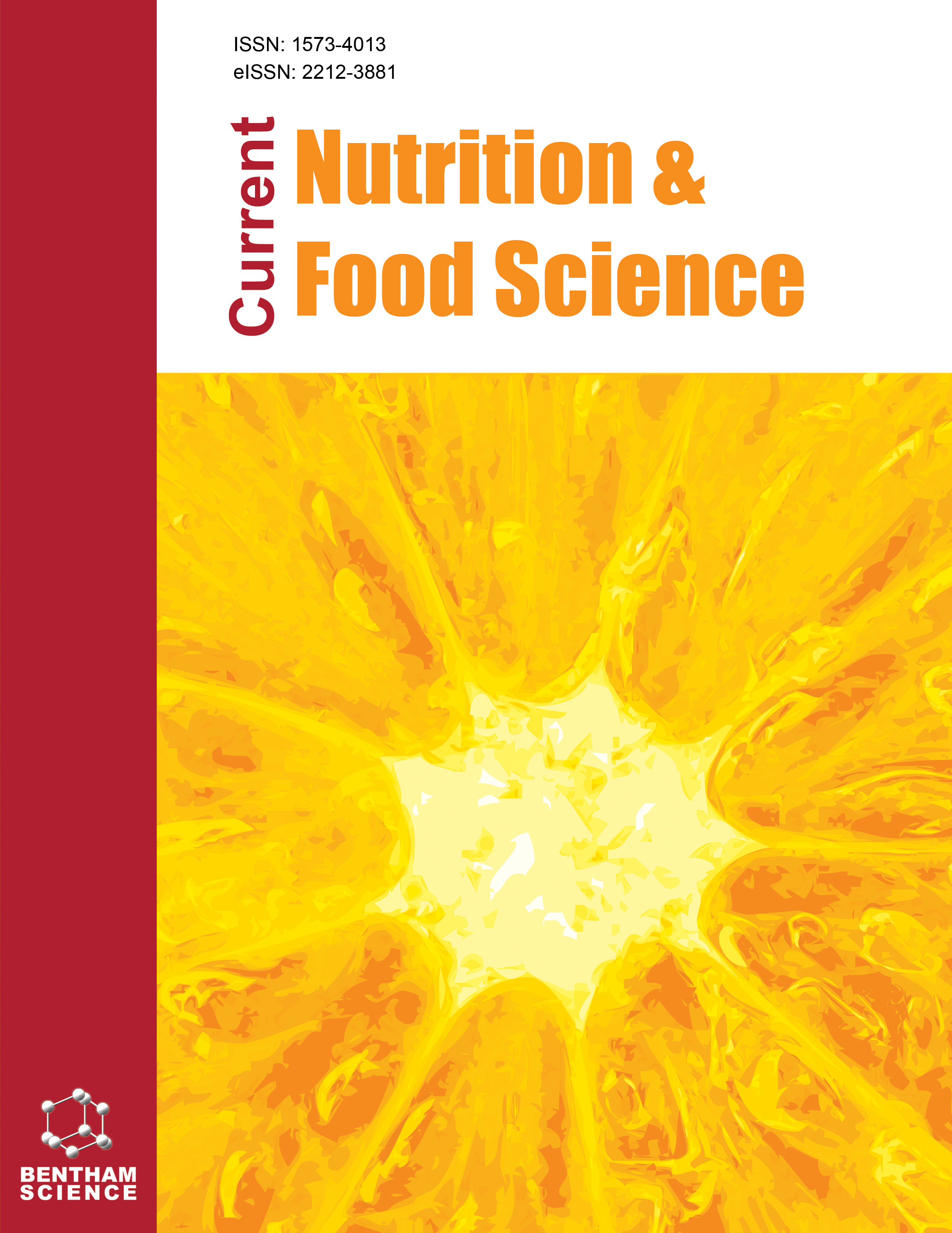- Home
- A-Z Publications
- Current Nutrition & Food Science
- Previous Issues
- Volume 19, Issue 1, 2023
Current Nutrition & Food Science - Volume 19, Issue 1, 2023
Volume 19, Issue 1, 2023
-
-
Calorie Restriction and Extracellular ATP on Health and Longevity- A Perspective
More LessAuthors: Gopikrishna Agraharam, Agnishwar Girigoswami and Koyeli GirigoswamiOxidative stress is known to be generated within the organism by endogenous cellular mechanisms and can also be generated by external factors. Oxidative stress is known to be involved in various disease pathologies such as cancer, osteoarthritis, cardiovascular diseases, ageing, etc. The chronic/acute exposure to oxidative stress can easily damage cellular integrity through damaging the cellular DNA, mitochondrial DNA, Read More
-
-
-
A Review on Importance of Biodegradable Packaging for Foods and Pharmaceuticals
More LessAuthors: Huma Shafi and Meenakshi BajpaiEverything we buy leaves a type of waste, particularly the packaging, which is thrown away when its contents are unpacked. One can hardly ignore the hazard plastic packaging poses to the environment. Plastic is a petroleum-based product that is a long128;term pollutant, it takes a very long time to degrade and is not fully biodegradable. The long-term development goals must incorporate protecting the environment and non Read More
-
-
-
Hypoalbuminemia Caused by Malnutrition and Total Joint Arthroplasties: A Narrative Review
More LessBackground: Albumin is the most abundant soluble protein in plasma, and it is a widely used and low-cost marker for the diagnosis of malnutrition. The serum albumin level below 35 g/L defines hypoalbuminemia. Objective: This review aims to discuss the role of albumin in the body, review hypoalbuminemia associated with postoperative complications in total joint arthroplasty surgeries, and examine the impact of nutritional Read More
-
-
-
Influence of Heating on the Physico-Biochemical Attributes of Milk
More LessBackground: Milk, the fluid secreted by the female of all mammalian species, fulfills the complete nutritional and energy requirements. Milk is a single balanced diet enriched in physiologically important proteins and peptides, enzymes, enzyme inhibitors, immunoglobulins, growth factors, hormones, and antibacterial agents. Milk can be converted to different dairy items that occupy an important place in confectioneries an Read More
-
-
-
The Human Right to Adequate Food in Brazil: A Multidisciplinary Approach
More LessAuthors: Raphael J. Prestes and Alberto Gonçalves EvangelistaOver the years, especially after the French Revolution and World War II, human rights have been internalized by several institutions and legislation worldwide, such as the United Nations (UN). However, in practice, much still needs to be done for the regulations to be applied. In Brazil, although the right to food is guaranteed in the Federal Constitution, there is still a wide disparity in per capita food acquisition in the different regi Read More
-
-
-
Does Maternal High-dose Vitamin D Supplementation During Pregnancy Increase Linear Growth Among Infants at One Year? - A Systematic Review and Meta-analysis
More LessAuthors: Saiful Islam, Abira Nowar, Tanjina Rahman and Oumma HalimaBackground: In pregnancy, maternal vitamin D deficiency has been associated with adverse birth outcomes worldwide and has become a major public health concern. However, the linkage between maternal prenatal vitamin D status and post-natal linear growth, particularly in infancy, is inconclusive and ambiguous. Objective: This study aims to systematically identify, appraise, and synthesize available evidence regarding Read More
-
-
-
Development of Photographic Food Atlas of Carbohydrate Servings of Banana Varieties Consumed in Enugu State for Dietary Counselling of Diabetic Patients
More LessBackground and Objectives: Intake of fruits as snacks for diabetic patients is usually encouraged, but there is the challenge of overconsumption and the inability to estimate the appropriate quantity to eat at a time. A photographic food atlas of three banana varieties (red Dacca, Gros Michel, and green mutant species) consumed in Enugu state, Nigeria, was developed using edible portions of foods that would supply a specific amo Read More
-
-
-
Differential Effects of Processing Methods on the Antioxidant Activity of Red and Cream Bambara Groundnut Seeds
More LessBackground: The red and cream bambara groundnuts (Vigna subterranea (L.) Verdc.) are generally grown in Thailand. Bambara groundnut seeds must be cooked before consumption. However, the differential effects of processing methods on the antioxidant activity of red and cream bambara groundnut seeds remain unknown. Objective: This study aimed to investigate the antioxidant activity affected by the steaming, boiling, a Read More
-
-
-
Does Nicotine from Passive Smoking and Foods Protect Against Parkinson’s Disease?
More LessBackground: There is generally a strong link between smoking, more particularly, passive smoking, and the occurrence of various illnesses and health-related disorders. Also, there is a globally recognized epidemiological link between smoking and Parkinson’s disease (PD). However, the current data on passive smoking are contradictory. Thus, this paper extracted the inconsistent existing studies to systematically shed lig Read More
-
Volumes & issues
-
Volume 21 (2025)
-
Volume 20 (2024)
-
Volume 19 (2023)
-
Volume 18 (2022)
-
Volume 17 (2021)
-
Volume 16 (2020)
-
Volume 15 (2019)
-
Volume 14 (2018)
-
Volume 13 (2017)
-
Volume 12 (2016)
-
Volume 11 (2015)
-
Volume 10 (2014)
-
Volume 9 (2013)
-
Volume 8 (2012)
-
Volume 7 (2011)
-
Volume 6 (2010)
-
Volume 5 (2009)
-
Volume 4 (2008)
-
Volume 3 (2007)
-
Volume 2 (2006)
-
Volume 1 (2005)
Most Read This Month
Article
content/journals/cnf
Journal
10
5
false
en


